This month we measured ice:
And we measured snow:

Recently our local paper picked up the story of the rise in popularity of the inquiry videos aimed at kindergarten to grade 3 students:
The Inquiry videos have attracted more than 1250 subscribers and have been viewed 40,000 times.
Watch a recent video about swamp sounds:
Watch the latest video about probability and weather:
What keeps the water in the upside down bucket?!
What lives in the hole in the ground??
Why is the pond water hard?
This month’s videos challenge young learners to think, question and develop strategies to find the answers.
Watch the inquiry videos. They have easy connections to Ontario Ministry of Education curriculum!
See the notes (underneath the YouTube video in the description) for learning extensions and links to more information.
How does the water stay in the bucket… even when it’s upside down?!
Who or what lives in the hole in the ground?!
What happened to the water?
See all the videos.
We’re always looking for ideas to support Kindergarten, Grade 1, Grade 2, Grade 3 learning with links to the Ontario curriculum and appropriate for homeschoolers and Forest School fans!
Subscribe and share!
I wear a different button everyday to school.
Last week one button on my shirt said “You are enough.”
During circle time an eight-year-old boy gently asked “What does that mean?”
I paused for a breath and the following fell out of my mouth:
So many people are told they are not tall enough, fast enough, big enough or smart enough.
Lots of people believe they are not good enough at math or art or reading.
Some people wish they were strong enough, kind enough, tough enough…
But you are enough.
You’re enough at SOMEthing.
You just need to find out what your thing is.
There was a pronounced pause and the boy quietly said, “That is wise.”
I’m not sure where those words came from, exactly, but they floated around in my head for the rest of the day.
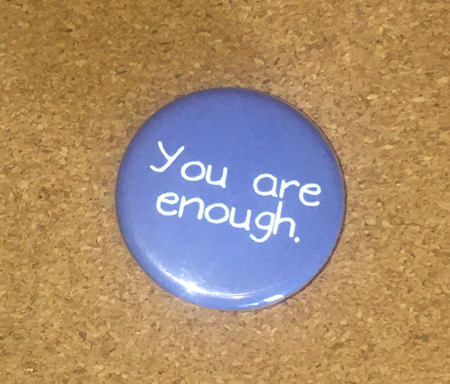
We spend so much energy in school and life focusing on narrow outcomes:
• excellence in math and literacy
• being stronger and faster
• attaining a university education
These are excellent goals. But many other traits or characteristics are overlooked or under-valued.
Ken Robinson describes a story of a student whose passion and skills to be a firefighter were spurned by a teacher as not good enough until, years later, his student saved his life in a car wreck.
A teacher at my 1980s high school was well known for rejecting a student’s desire and talents in music. Later, the student, Bryan Adams rocketed to fame and fortune.
As a boy, Ingvar had a tough time in school. His father told him he wouldn’t go anywhere in life. He was dyslexic but had an aptitude to think differently. Despite his challenges, he was good enough to build IKEA from a tiny business to an enormous company.
Stephen Wiltshire, as a child, would not speak. His language abilities were minimal. He didn’t socialize well. But he had an amazing ability to memorize enormous details – enough to reproduce cityscapes on paper from memory. He is now a world-renowned, architectural artist.
Many real superheroes start out with enormous challenges.
With support, tenacity and/or good fortune, they discover their (sometimes hidden) talents were more than good enough.
As a teacher, I support students’ challenges.
More importantly though, I seek to recognize students’ true talents and help them shine. They are enough. We just need to discover their true strengths to let them shine!
People around the world banded together recently to urge for change to help earth.
At school I see a wide range of views from young students. Most are keen to help but can be limited in knowledge and resources. What can you do to help young people help the planet?
• Lead by example!
Children are sponges and mimic those they hold in high regard. If you compost, recycle and pack lunch with re-usable containers, it’s likely they will, too. Our son came home and told me he needed a container to bring his lunch/snack compost waste home. He made me smile. His teacher is making a difference.
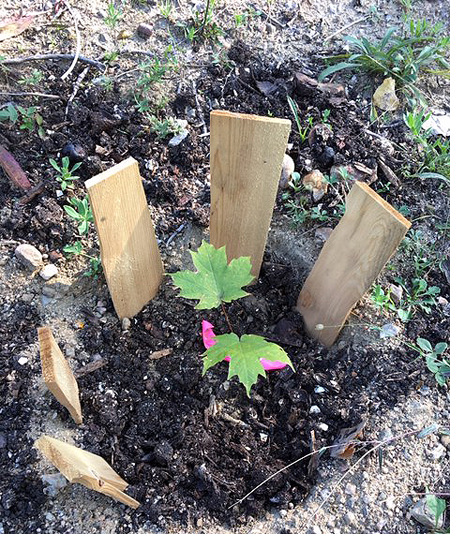
• Talk
In class we talk about factors affecting the environment. Discuss options for getting around: using bikes, public transit, electric/hybrid and gas car.
Discuss the benefits? Costs? Modelling critical reasoning is a valuable skill for youth to experience (and adopt.)
It doesn’t take a lot for young people to understand and appreciate .
• Bring nature to the classroom
I love trees!
I bring trees and plants into classroom learning. Trees can be used in science (soils, life, photosynthesis) and in literacy (describe/compare, narrative, read aloud…)
In math, trees can be used to recognize and create patterns as well as measurement.
After a month of learning, we plant the class tree somewhere at the school. I asked one student if she ever went to see her class tree. Without hesitation she beamed “Everyday!”
Trees can be a powerful learning tool! Bring your own environmental passion to the classroom.
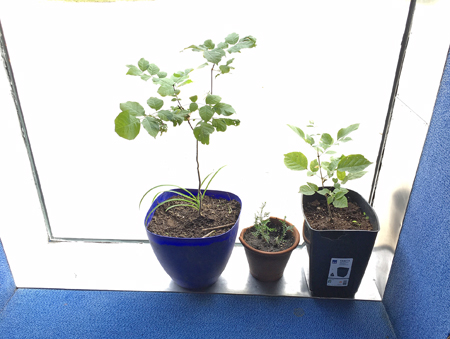
• Goals
Set goals with your students/children. Every little positive environmental action helps…
Will you:
1. Plant trees?
2. Walk, bike, car pool?
3. Reduce/eliminate purchases with excessive packaging?
4. Compost
5. Choose alternatives to fossil fuels?
Help the earth.
Teach the children…
Real superheroes are often in disguise…
They are real people who do extra-ordinary things. I like to bring the superhero ideas into the classroom…
Last year I wrote about superheroes in the classroom.
Below I share:
• Three real superheroes
• A CBC clip about a teacher who brings superheroes to her classroom
• Ideas for using superheroes to meet curriculum expectations
Like Gladys West, who developed the mathematics behind GPS technology. She overcame enormous hurdles to set the groundwork for technology that many people in North America and Europe take for granted. Hurdles? She’s an African American woman who grew up in the 1920’s when women and people of African heritage were not supposed to shine. She shone brightly in the world of mathematics but did not receive much recognition for her work until recently.

Or mild mannered Mr. Rogers and “Officer” Clemmons who battled racial segregation on mainstream television in a gentle and welcoming way by sharing the spotlight and a pool in the children’s tv show. Today, that’s not so unusual. In 1969, in America, that was unheard of. But it helped challenge deep seated bigotry in the USA.
Or Cecilia Payne, born in 1900, who proposed groundbreaking astrophysical theories against all odds. Her mother refused to pay for her education. She was a woman working in a man’s field. Other scientists denounced her theories. But she persisted and lay the groundwork for modern understanding of our universe.
I like using real superheroes in the classroom. Links to literacy, art and character education offers all kinds of unit plans with backward design.
Start by finding the end result – a real life superhero – and work backwards to research who they are and what makes them tick. Extend the activity to connect to the student’s self – what are the student’s hidden superpowers?!
Others, like Marjorie White (featured in the CBC clip below), use superheroes to motivate students:
Who are your real life superheroes?
Who do you admire?
What is YOUR super power?!
A young student does something wrong.
They’re told to apologize.
They do.
And then nothing changes…
There’s a lot wrong with this scenario.
The student upsets someone or something. Yes, that’s unfortunate but it happens. I like to think of these ‘oopses’ as potential for learning. Often the student is asked or told or expected to apologize and, usually, the student knows the easy way out – “I’m sorry…”
The trouble is – in many cases – the student is not sorry. They want to get out of trouble quickly, go through the ‘sorry’ steps and get back to what they want to do. The greater injustice is that, oftentimes, the student’s undesirable behaviour does not change or is reinforced.
This winter a student from another class routinely stepped over the boundaries of school rules and general decorum. He was a high-flying prankster constantly pushing the envelope of acceptable behaviour. He’d been trained to keep playing his get out of jail “sorry” card.
The last time he said ‘sorry’ with his big goofy grin and an expectation of absolution, I stopped.
“I don’t think you are sorry,” came from my mouth. His smile faded with the recognition that his normal routine had hit a snag. He stood quietly, unsure what to say…
“If you were sorry you wouldn’t keep running and yelling in the halls between classes.” More silence…
“I would know you were sorry if you at least attempted to make a change.”
And I let him go…
That was the start of a slow change.
The next time I taught his class I met him at the door. I asked why I should let him in. “I could just give you your work. You could do it in the office… I don’t like it when your behaviour disrupts others. How do I know you’ve changed or are willing to change?”
That was the start of a gradual evolution. It required time and consistency and more energy than demanding ‘sorry.’ It required our relationship to grow.
The end result was better. But the cost was higher.
Most people think teachers teach math or language or science, etc. They do, but the more important job is to develop the whole person. That takes more time and effort – often more effort than the teacher has time for.
Don’t accept a meaningless apology. It’s the extra step that makes the difference to a student and a community.
Last fall, I carted six trees into my classroom.
They fit nicely on the window ledge.
They also fit nicely into the curriculum:
• We wrote about the differences and similarities of the leaves.
• We compared the mathematical patterns and measured their sizes.
• We studied the science of trees as oxygen producers.
• We included them in art.
• We discussed the social impact of trees on neigbourhoods.
… And then we planted two trees as a lasting memory of the learning and gift to the school/neighbourhood.
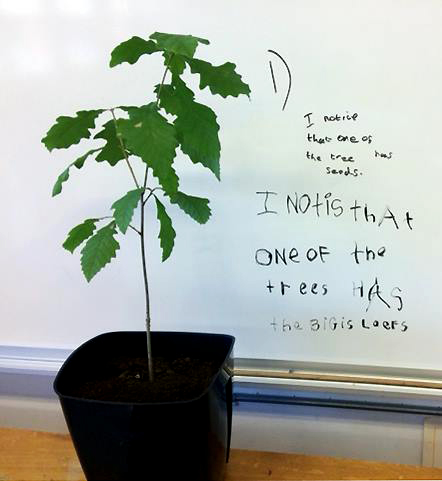
In the current state of our climate – more frequent floods, big storms and weather anomalies – bringing attention to the carbon capturing potential of trees at any grade level is a good thing.
I’d like to see trees planted as many places as possible. Schools and students are a great place to plant the seeds, metaphorically and literally. Growing trees in your class is possible and easy:
• Plant some apple seeds from a student’s lunch apples and see what happens.
• Contact groups like Ecology Ottawa and ask about their free seedling giveaways.
• Collect seeds in the fall and explore the process of seed germination (this can be challenging.)
Trees for life!
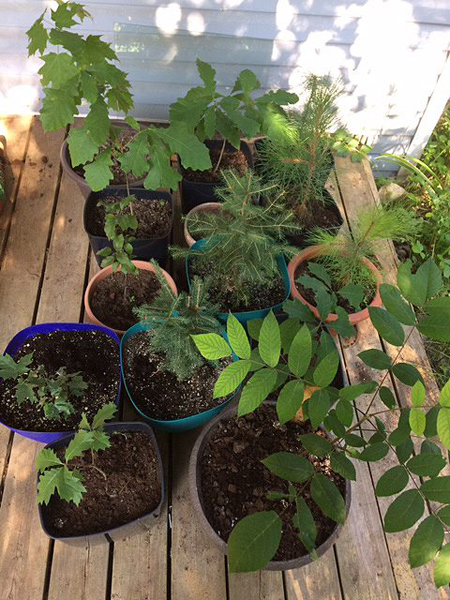
“You’re too fat.”
“Why would you want that?”
“Oh, come on. That’s so easy!”
Small words have lasting effects on brain development in youth and the “prevalence of anger, hostility and depression in adulthood.” (PsychologyToday.com)
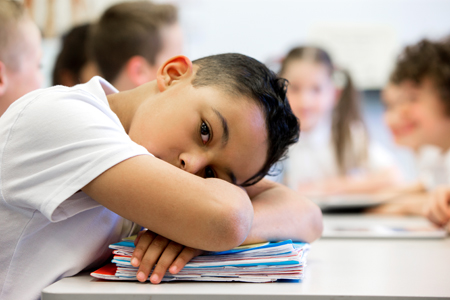
Developmental Roots
I’ve always been fascinated by the factors that turn people into who they are. There are enormously diverse factors – nature and nurture.
Our genes and predispositions are hard to change – propensity towards height, specific intelligences.
Environmental factors, of course, have a large impact on development – adequate shelter, nourishment affect the ability to grow and stresses on growth.
Social factors also have an enormous effect on the development of a person. Vygotsky built his socio-cultural theory of learning on the idea that we are products of the people that surround us.
Choosing Support
A good friend once told me “Surround yourself with supportive people.” I believe that is sage advice and will support a stronger, healthier person – and I do not mean physical strength.
Providing Support
Imagine growing up being told, regularly, by people you look up to (teachers, family, coaches) you’re too thin, fat, not good enough, disappointing. Direct words have a great impact but subtle insinuations, disapproving glances also have a lasting effect if repeated enough. Many will start to believe what they’re told.
Imagine, instead of focusing on negatives, the same people sought to comment on positives:
• “You look good.”
• “I like that book you’ve chosen.”
• “You really did well with that jigsaw puzzle.”
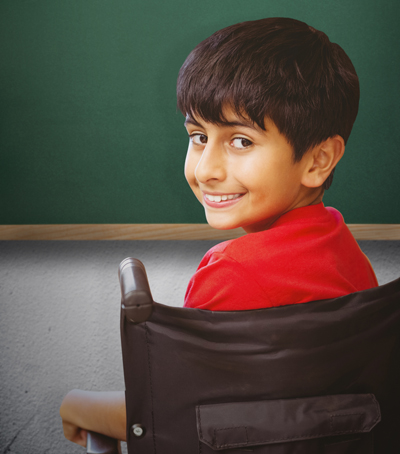
When I adopted my first dog in the early 1990’s I sought help to help me create an easy canine companion. I stumbled upon a book at the local library called “Training your dog positively.” It’s message was simple and applied so well to my philosophy in teaching: Acknowledge and address the shortfalls (simply/quickly) but regularly praise and promote the successes!
Success
At school I hear and see the results of positive and negative support. Children that are offered more positives and told they will succeed generally do. Children that experience more negativity often struggle with confidence and success.
Two Options for Improving
There are two sides to the issue.
It would be lovely to just ask the world to praise and pursue positive support (while supporting challenges.) That means asking people (including you and me) to reflect and be aware of the impact of our words and actions on people. Less judgment. More positive support.
But that is a lofty goal.
Another option is to arm children with the skills to shield themselves from negativity and pursue positive role models – another challenging goal. I see children who withstand negative influences regularly. Their role models are doing the best they can… But we can encourage children to recognize their own worth and help them seek positive friends and influencers. “Surround yourself with suportive people…”
Listen, choose your words well, and smile.
A friend was upset recently that his elementary-aged student lost recess time for minor misdemeanors in the classroom. He was upset. I would be, too. Why do kids lose recess? It’s complicated…
Children need time to play, run and explore in unstructured ways. Often, that means recess.
If the child is like me, sitting still in rows and quietly learning, is purgatory. Moving, exploring and learning through experiences is how I learn best. Taking some of that away – even just one recess – creates more stresses than successes. Thankfully classrooms and schools are changing from past norms.
Schools from the past often placed students quietly in rows where they were supposed to diligently do their work, quietly. Some suggest ‘modern’ school was an industrial idea to prepare workers for factories.
Luckily this thinking is changing.
I still hear of instances of active children who are denied recess for misbehaviours. In my mind, ‘busy’ children should receive double recess for misdemeanors. Disallowing active free play can escalate challenges.
Reducing Misbehaviours
I currently teach a little bit of Forest School. What draws me to their learner led philosophy? Students lead the learning. Kids are engaged and active because they follow their passions. Teachers build the curriculum around the student interest. Consequently, there are very few mis-behaviours to manage.
What’s going on with some kids in traditional schools?
I teach mostly in traditional classrooms. Misbehaviours happen. Recently, I sat beside a boy who had consumed much of my attention as I got the class going. He squirmed and disrupted those around him. I looked at him. “You’re bored aren’t you?” He looked at the floor and nodded his head. Instead of threatening a consequence – like taking his recess – I asked what he wanted to do. We worked a way to combine his interests with curriculum elements. Happily for all, his behaviour improved.
Why teachers take away recess.
Teachers threaten students with losing recess, I believe, because they’re often strapped for time, energy and need a quick way to keep a student in line. Although it’s short-sighted, some teachers have their limits and, despite best intentions, resort to recess loss as a way to keep the class moving forward. Without an outlet or release, the student’s behaviours can escalate and create more challenges.
What others say about recess and taking away recess:
The Atlantic offers discipline research, suggestions and alternatives to taking away recess:
Education Weekly suggests the practice of taking away recess is declining and offers support for recess.
The Huffington Post cites findings on the subject from the American Academy of Pediatrics.
Two alternatives to losing recess:
1. Differentiate.
This is education lingo for meeting all students where they are. It means keeping all students interested in learning whether they are at grade level, or way behind or way ahead. Keeping all students interested will help reduce unwanted behaviours. It’s the ideal in classrooms.
However, differentiation takes planning, insight, resources (time and $) and experience.
It also means teachers need to account for students who are chronically hungry or have a stomach ache or who live with a single parent who struggles to make ends meet. Sometimes the behaviours stem from stresses or traumas beyond the context of school. Some students never develop the basic social skills to get along in a school environment.
I have seen classes where one student can consistently derail an otherwise well functioning learning environment. Sometimes, that student has little support at home and may only be operating at the lowest tier of Maslow’s hierarchy. It’s hard to be ready for learning if you’re worried about food or shelter or safety. Which brings me to alternative 2 to losing recess.
2. More support.
And I mean more support on many levels such as:
• Support in the class for students that need it. A good educational assistant is worth their weight in gold. Smaller class sizes help.
• Support for families that are struggling. This could mean support for families that do not have the basics of food and shelter… or families that have developed poor coping skills for life’s ills. Support could be for families struggling with loss, mental or physical health challenges, stress.
• Support for schools: More teachers, more educational assistants, more people, more time means better student development.
All this support means more big picture $. That’s a big issue that will not always welcome support. However, The CBC documents that money spent on early education / family support goes a long way in saving money down the road.
The NY Times offers research and more research that equates more educational spending benefits society.
The American Prospect suggests that (in the USA) there is a correlation between jails and education: “The lowest-performing schools tend to be in the areas where incarceration rates are the highest.”
Would more support for schools and neighbourhoods lead to less need for jails? I think so.
So… taking away recess from misbehaving children?
Think again.
Support schools. Support teaching staff. Support social services. This support will create better lives for all.